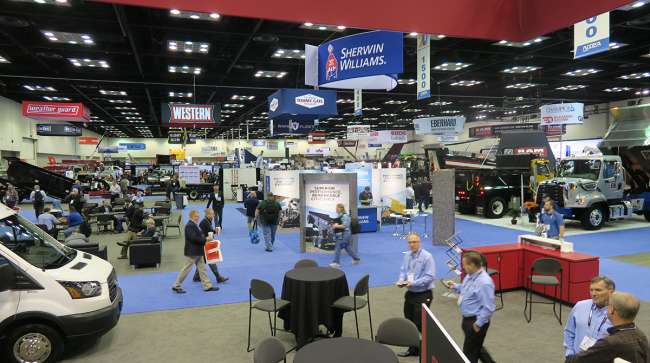Staff Reporter
Future Truck Trends on Display at Work Truck Show

[Stay on top of transportation news: Get TTNews in your inbox.]
INDIANAPOLIS — The momentum with which electrification for commercial trucks is evolving was a key topic at the Work Truck Show and accompanying Green Truck Summit here, with discussions focused on the technology’s potentially robust pulling power, the challenges of building out a charging network and the pace at which innovation and consolidation are constantly bringing change to this nascent market.
“There are benefits to EVs beyond the green factor,” Penske Transportation Solutions Vice President Bill Combs said during a panel discussion at the day-long Green Truck Summit on March 3. “The power for a truck driver that’s in a Class 8 tractor-trailer going uphill [and] doesn’t need to go below 65 mph — that truck will maintain a 65 mph speed at 80,000 pounds. That adds a nice factor for the driver. Maybe the range isn’t as long but they can get to their destination faster.”
Ensuring there are places to charge those trucks, however, is a challenge to overcome, he noted.
“I think it’s an industry problem to solve,” Combs said. “I’m very curious to watch how this network of charging stations builds itself out for commercial use.”

Combs
He mentioned loading docks, truck stops, warehouses and distribution centers as good spots to focus on this build-out, but noted that technical standards must be in place to ensure a smooth rollout, especially with establishing sizes for things like charging ports.
“Figuring out how to scale charging is really going to be a critical path forward,” added Jason Mathers, director of vehicles and freight strategy at the Environmental Defense Fund, in an interview with Transport Topics. “I think that is going to be the long-term challenge in this space. There are lots of opportunities. I think in the next couple of years we’re going to further understand how to best deploy charging strategies that enable fleets to charge themselves quickly and cost effectively.”
He noted, however, that truck manufacturers appear ready; he pointed to about seven electric trucks that were production-ready on the showroom floor.
Reaching this point has been a journey, noted Peter Miller, vice president of sales and business development at ProTech Industries.

Miller
“You look back 10 years ago and there were a lot of individual companies,” he told TT. “They were first-generation, second-generation and sometimes third-generation. Now, what started maybe eight years ago [is] private equities started coming in and buying up those companies. The roll-ups have really increased in the last five years — it’s just lightning speed and it’s not slowing down.”
Miller pointed to how consolidation has affected the exhibit floor at Work Truck Show, noting that in some cases as many as eight individual companies were exhibiting in one booth.
Now, however, the commercial truck space is ready for adoption, said Kash Sethi, vice president of sales at Motiv, a company that develops software platforms for the electrification of medium-duty trucks and buses.
“Especially in the medium-and heavy-duty segments,” he told TT. “The fleets are a lot more receptive to it. They understand they need to do it. Many of them have deployed vehicles for years and have proven the operational and maintenance savings, instead of just believing white papers.”
One question, however, is whether electric power can leapfrog other clean-fuel technologies that are developmentally farther along — notably, compressed and liquefied natural gas, said Rush Enterprises National Account Manager Bobby Stanley.
“It’s been talked about for six or eight years really heavily,” Stanley said of electrification. “There are a lot of prototypes out — there are a lot of things from an electric standpoint that are out there running around.”
Host Seth Clevenger went to CES 2020 to look at the road ahead for electric-powered commercial vehicles. He spoke with Scott Newhouse of Peterbilt and Chris Nordh of Ryder System. Hear a snippet, above, and get the full program by going to RoadSigns.TTNews.com.
He acknowledged, however, that there are few other workable options on the market.
“Other than CNG, LNG or propane, there really isn’t something, I feel, that is viable on the market today that can run every day,” he said.
“I would say electrification is far ahead in terms of being on the road today,” Sethi said.
John Ruppert, general manager of commercial and fleet sales at Ford Motor Co., reflected on how the trends of consolidation and electrification have leapt to the forefront in a fairly short amount of time.
“When I was here two years ago we talked for a few minutes about three emerging trends,” Ruppert said during a March 5 press event. “One was consolidation — both in our industry and in yours. We talked about the advancements in lightweight materials in our work and what we build — on the OEM side and on yours. And the third thing was electrification.”
Want more news? Listen to today's daily briefing:


